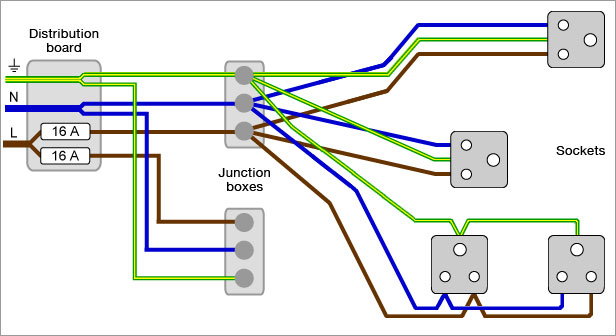 |
Radial and Ring circuits different domestic wiring techniques |
info page |
BS 1363 |
 |
Radial and Ring circuits different domestic wiring techniques |
info page |
BS 1363 |
| Radial circuit wiring |
 |
|
In a radial circuit power is transmitted from point to point by a single length of cable linking each point to the next. It starts at the main fuse box and terminates at the last connected device. Intermediate junction boxes may connect individual sockets or chains of several sockets, but there is never a loop wiring structure. The radial circuit system is shown with old British BS 546 type sockets. However, any other type of socket can be applied. Worldwide, radial wiring is by far the most commonly used technique. |
| Ring circuit wiring |
 |
|
A ring circuit provides
two independent conductors for line, neutral and protective earth for
each connected socket (see scheme above). If the load is evenly split across the two directions the amperage in each direction is half of the total, allowing the use of wire with half the current-carrying capacity. The concept of ring circuit wiring was developed by the Electrical Installations Committee which was convened in 1942 as part of the Post-War Building Studies programme. Ring circuit wiring offered a more efficient and lower cost system which would safely support a greater number of sockets. The lower costs aspect was related to fact that wires with a smaller diameter could be used, compared to radial wiring. Shortly after World War II there was a considerable demand for building materials. Among other things, a limited availability of copper was to be expected. However ring wiring was not driven by copper shortage. From the late 1940s new houses and buildings were wired according to the ring technique. Gradually circuits in older houses were rewired. By the end of the 1960s BS 1363 was the prevalent standard, but BS 546 has never fully disappeared. Ring
circuits provide
low protection against overcurrents. Ring circuits usually
supply a large number of sockets, and have to be protected with
high-rated overcurrent circuit breakers (typically 32 A). To
minimize safety risks - ring circuits can deliver more current than
appliance flexible power cords can handle - each plug requires a fuse,
rated to protect the flexible cord attached to the plug. Each
individual BS 1363 plug is fused with a BS 1362 25 mm
ceramic cartridge fuse. Preferred ratings are 3A and 13A, but other
ratings exists. A detailed report about
advantages, disadvantages and history of BS 1363 13A plugs and ring
circuits can be downloaded from the IET site (Institution of Engineering and Technology).
Note that Ireland, which has radial circuit wiring rather than ring circuit, also uses BS 1363 plugs and sockets. Ireland has replaced the previously existing mixture of Schuko and BS 546 for BS 1363 to eliminate incompatibilities between the Republic of Ireland and Northern Ireland. Moreover, the change was an effective step in standardization of the system in Ireland. The Irish standards for devices comparable with BS 1363 are IS 401 (13A plugs), IS 411 (switched and unswitched sockets) and IS 421 (adapters). In addition to the UK and Ireland, BS 1363 plugs and sockets are used in quite a number of countries that were electrified by the British. It is likely that most of them still have radial circuits wiring.
|
|
|
|
|
|
|